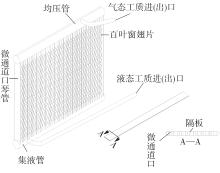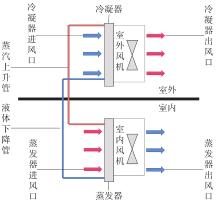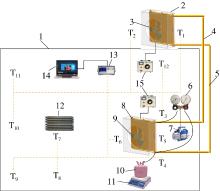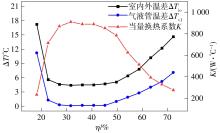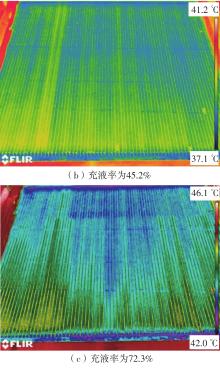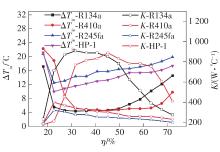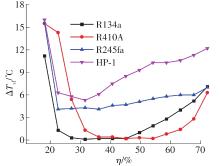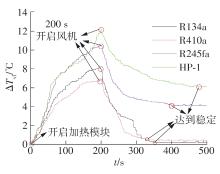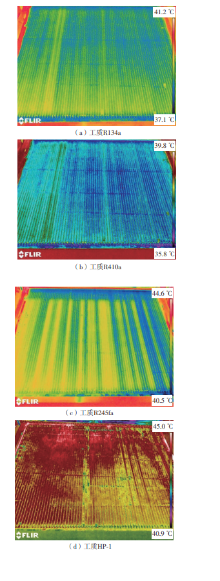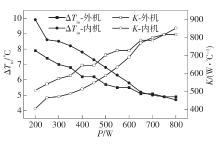Journal of South China University of Technology(Natural Science Edition) ›› 2023, Vol. 51 ›› Issue (6): 109-118.doi: 10.12141/j.issn.1000-565X.220499
Special Issue: 2023年能源、动力与电气工程
• Energy,Power & Electrical Engineering • Previous Articles Next Articles
Experimental Study on Heat Transfer Performance of Separated Heat Pipe Heat Exchanger in Communication Base Station
GAN Yunhua1 LIAO Yuepeng1 YUAN Hui2 LIU Fengming2 LI Yong3
- 1.School of Electric Power Engineering,South China University of Technology,Guangzhou 510640,Guangdong,China
2.Guangxi Free Trade Zone Jianju Technology Co. ,Ltd. ,Qinzhou 535000,Guangxi,China
3.School of Mechanical and Automotive Engineering,South China University of Technology,Guangzhou 510640,Guangdong,China
-
Received:2022-08-11Online:2023-06-25Published:2022-10-21 -
Contact:甘云华(1979-),男,教授,博士生导师,主要从事微通道传热等方面的研究。 E-mail:ganyh@scut.edu.cn -
About author:甘云华(1979-),男,教授,博士生导师,主要从事微通道传热等方面的研究。 -
Supported by:National Natural Science Foundation of China(51776077);the Project of Central Guidance and Local Science and Technology Development Fund(Guike ZY22096022);the Guangdong Basic and Applied Basic Research Foundation(2020B1515020040)
CLC Number:
Cite this article
GAN Yunhua, LIAO Yuepeng, YUAN Hui, et al. Experimental Study on Heat Transfer Performance of Separated Heat Pipe Heat Exchanger in Communication Base Station[J]. Journal of South China University of Technology(Natural Science Edition), 2023, 51(6): 109-118.
share this article
| 1 | 安涛,何明宪 .双碳目标达成与移动通信基站节能减排技术的探索[J].移动通信,2022,46(3):93-98,102. |
| AN Tao, HE Mingxian .Exploration on energy conservation and emission reduction technology of mobile communication base station under double carbon target[J].Mobile Communications,2022,46(3):93-98,102. | |
| 2 | GAN Y H, WANG J Q, LIANG J L,et al .Development of thermal equivalent circuit model of heat pipe-based thermal management system for a battery module with cylindrical cells[J].Applied Thermal Engineering,2020,164(C):114523/1-11. |
| 3 | LIANG J L, GAN Y H, LI Y,et al .Thermal and electrochemical performance of a serially connected battery module using a heat pipe-based thermal management system under different coolant temperatures[J]Energy,2019,189(C):116233/1-16. |
| 4 | 甘云华,王建钦,梁嘉林 .基于热管的圆柱形电池包冷却性能分析[J].化工学报,2018,69(5):1964-1971. |
| GAN Yunhua, WANG Jianqin, LIANG Jialin .Cooling performance of cylindrical battery pack based on thermal management system with heat pipe[J].CIESC Journal,2018,69(5):1964-1971. | |
| 5 | HE L F, TANG X W, LUO Q L,et al .Structure optimization of a heat pipe-cooling battery thermal management system based on fuzzy grey relational analysis[J].International Journal of Heat and Mass Transfer,2022,182:121924/1-14. |
| 6 | 甘云华,黄昭惠,梁嘉林,等 .部分压扁热管等效导热模型特性研究[J].华南理工大学学报(自然科学版),2021,49(10):123-132. |
| GAN Yunhua, HUANG Zhaohui, LIANG Jialin,et al .Research on the characteristics of conduction-based model of partially flattened heat pipe[J].Journal of South China University of Technology (Natural Science Edition),2021,49(10):123-132. | |
| 7 | HUANG G W, LIU W Y, LUO Y Q,et al .A novel ultra-thin vapor chamber for heat dissipation in ultra-thin portable electronic devices[J].Applied Thermal Engineering,2020,167(C):114726/1-10. |
| 8 | 唐恒,汤勇,万珍平,等 .平板铝热管微沟槽吸液芯的制备及毛细性能研究[J].机械工程学报,2019,55(6):186-193. |
| TANG Heng, TANG Yong, WAN Zhenping,et al .Fabrication and capillary performance of micro-grooved wicks for aluminium flat-plate heat pipes[J].Journal of Mechanical Engineering,2019,55(6):186-193. | |
| 9 | BUFFONE C, COULLOUX J, ALONSO B,et al .Capillary pressure in graphene oxide nanoporous membranes for enhanced heat transport in loop heat pipes for aeronautics[J].Experimental Thermal and Fluid Science,2016,78:147-152. |
| 10 | 刘海潮,邵双全,张海南,等 .回路热管微通道换热器蒸发冷却实验[J].化工学报,2018,69(S2):161-166. |
| LIU Haichao, SHAO Shuangquan, ZHANG Hainan, et al .Evaporative cooling experiment of microchannel heat exchanger in loop heat pipe[J].CIESC Journal,2018,69(S2):161-166. | |
| 11 | 王飞,王建民,邵双全 .数据中心冷却系统多级传热温差分析[J].化工学报,2021,72(S1):348-355. |
| WANG Fei, WANG Jianmin, SHAO Shuangquan .Analysis multi-stage heat transfer process of data center cooling system from the temperature difference[J].CIESC Journal,2021,72(S1):348-355. | |
| 12 | 严浩,刘刚,洪旸,等 .动力型分离式热管MATLAB稳态传热模拟[J].建筑热能通风空调,2022,41(2):22-25,17. |
| YAN Hao, LIU Gang, HONG Yang,et al .Matlab steady state heat transfer simulation of dynamic separated heat pipe[J].Building Energy & Environment,2022,41(2):22-25,17. | |
| 13 | 佟振,李晓瑞 .CO2分离式热管在数据中心的应用[J].制冷学报,2021,42(1):67-73. |
| TONG Zhen, LI Xiaorui .Application of CO2 two-phase thermosyphon loop in data centers[J].Journal of Refrigeration,2021,42(1):67-73. | |
| 14 | ZHANG H N, SHI Z C, LIU K T,et al .Experimental and numerical investigation on a CO2 loop thermosyphon for free cooling of data centers[J].Applied Thermal Engineering,2017,111:1083-1090. |
| 15 | 刘玉清,郭佳超,李浩鹏,等 .多角度重力型分离式热管蒸发器的压降特性研究[J].科学技术创新,2020(12):39-40. |
| LIU Yuqing, GUO Jiachao, LI Haopeng,et al .Study on pressure drop characteristic of multi-angle gravity separated heat pipe evaporator[J].Scientific and Technological Innovation,2020(12):39-40. | |
| 16 | YAO M L, GAN Y H, LUO Q L,et al .Experimental study on the effect of filling ratio on an R141b two-phase thermosyphon loop with a horizontal parallel tube evaporator[J].International Journal of Refrigeration,2022,137:230-243. |
| 17 | YUE C, ZHANG Q, ZHAI Z Q,et al .Numerical study on flow and thermal characteristics of a micro-channel separated heat pipe under various surface wettability[J].Case Studies in Thermal Engineering,2021,28:101345/1-12. |
| 18 | DING T, CAO H W, HE Z G,et al .Visualization experiment on boiling heat transfer and flow characteristics in separated heat pipe system[J].Experimental Thermal and Fluid Science,2018,91:423-431. |
| 19 | 郝长生,尤占平 .通信基站用热管换热器试验研究和节能分析[J].暖通空调,2017,47(7):75-79,70. |
| HAO Changsheng, YOU Zhanping .Experimental study and energy saving analysis of heat pipe exchanger used in communication base stations[J].Heating Ventilating & Air Conditioning,2017,47(7):75-79,70. | |
| 20 | XIA G H, ZHUANG D W, DING G L,et al .A quasi-three-dimensional distributed parameter model of micro-channel separated heat pipe applied for cooling telecommunication cabinets[J].Applied Energy,2020,276:115544/1-14. |
| 21 | WANG T, LI Y H, LIU H,et al .The energy efficiency analysis of data center cooling based on separated heat pipe[C]∥ Proceedings of International Heat Transfer Conference 16.Beijing:Begell House Inc.,2018:3647-3654. |
| 22 | 张泉,吴亚凝,凌丽,等 .基站用微通道分离式热管换热性能实验研究[J].湖南大学学报(自然科学版),2016,43(7):139-145. |
| ZHANG Quan, WU Yaning, LING Li,et al .Experimental investigation on heat transfer characteristic of micro-channel separated heat pipe in telecommunication base station[J].Journal of Hunan University (Natural Sciences),2016,43(7):139-145. | |
| 23 | 杨春英,宋志鹏,魏培恒 .基站用分离式热管的研究[J].节能技术,2016,34(2):182-185,193. |
| YANG Chunying, SONG Zhipeng, WEI Peiheng. Separated heat pipe system in communication base station[J].Energy Conservation Technology,2016,34(2):182-185,193. | |
| 24 | MOFFAT R J .Describing the uncertainties in experimental results[J].Experimental Thermal and Fluid Science,1988,1(1):3-17. |
| 25 | 洪光,张春辉,罗晴,等 .常温小温差下的分离式热管换热器充液率研究[J].节能,2011,30(1):24-27,2. |
| HONG Guang, ZHANG Chunhui, LUO Qing,et al .The separating heat-pipe filling rate study with the normal temperature and small temperature difference[J].Energy Conservation,2011,30(1):24-27,2. | |
| 26 | 张红 .分离式热管换热器最佳工作状态的研究[J].石油化工设备技术,1996,17(3):13-17. |
| ZHANG Hong .Investigation on the optimized working status of separate type heat pipe heat exchangers[J].Petrochemical Equipment Technology,1996,17(3):13-17. | |
| 27 | 庄骏,张红 .热管技术及其工程应用[M].北京:化学工业出版社,2000:67. |
| [1] | ZHANG Dong, XU Baorui, WANG Sen, et al. Experimental Study of Non-Symmetry Micro Channel Flat Plate Pulsating Heat Pipe Under Variable Conditions [J]. Journal of South China University of Technology(Natural Science Edition), 2023, 51(8): 51-61. |
| [2] | XIE Zhihui, LIU Hanyu, WU Jiechang, et al. Numerical Analysis with Thermal-Magnetic-Fluid Coupling on Enhanced Heat Transfer for Shell-and-Tube Heat Exchanger [J]. Journal of South China University of Technology(Natural Science Edition), 2023, 51(3): 22-32. |
| [3] | GAN Yunhua, LIU Runxi, YUAN Hui, et al. Performance Analysis of Integrated Micro-Channel Heat Exchanger [J]. Journal of South China University of Technology(Natural Science Edition), 2023, 51(3): 13-21. |
| [4] | ZHANG Dong, HOU Hongyi, LI Qingliang, et al. Analysis of Operation Characteristics of Pulsating Heat Pipe Under the Condition of Non-uniform Heat Flux [J]. Journal of South China University of Technology(Natural Science Edition), 2022, 50(7): 126-135. |
| [5] | LI Yong, SHE Peijian, OU Qiguan, et al. Approach Of Width Measurement Of Irregular Ultra-Thin Heat Pipe Based On Machine Vision [J]. Journal of South China University of Technology(Natural Science Edition), 2022, 50(4): 46-55. |
| [6] | GAN Yunhua, HUANG Zhaohui, LIANG Jialin, et al. Research on the Characteristics of Conduction-Based Model of Partially Flattened Heat Pipe [J]. Journal of South China University of Technology (Natural Science Edition), 2021, 49(10): 123-132. |
| [7] | MENG Fankai, CHEN Zhaojun, XU Chenxin, et al. Comprehensive Performance Analysis of Thermoelectric Coolers Based on Heat Pipe Heat Dissipation [J]. Journal of South China University of Technology (Natural Science Edition), 2021, 49(10): 104-113. |
| [8] | LI Yong, XU Peiken, YANG Shifan, et al. Thermal Performance of Roll Bond Aluminum Vapor Chamber [J]. Journal of South China University of Technology (Natural Science Edition), 2020, 48(2): 34-41. |
| [9] |
CAI Huikun WENG Zeju LIAO Yidai SU Lijun.
Heat Dissipation Characteristics of Plate-fin Heat Exchanger with Internal Flow Channel
|
| [10] |
LI Yong XIE Peida ZHOU Wenjie LIAO Boliang HE Bolin CHEN Chuangxin.
Analysis of the Thermal Performance of Micro-Diameter Heat Pipes with Composite Wick
|
| [11] | CAI Hui-kun ZHANG Yin-liang LIAO Yi-dai HE Tian-fu. Performance Analysis of Different Radiator Fins at Various Altitudes [J]. Journal of South China University of Technology (Natural Science Edition), 2017, 45(2): 91-98. |
| [12] | ZHOU Jian-yang LUO Xiao-ping FENG Zhen-fei DENG Cong WU Di. Analysis of Heat Transfer Channel Surface Characteristic of Micro Heat Exchanger Based on Young's Theory [J]. Journal of South China University of Technology (Natural Science Edition), 2017, 45(1): 123-128. |
| [13] | XIA Qin-xiang LI Zhi-wei LONG Xiao-bin LONG Chuan. Investigation into Warpage Deformation and Corresponding Parameters in Expanding-Jointing Process of Air Conditioner Fin [J]. Journal of South China University of Technology (Natural Science Edition), 2016, 44(2): 33-39. |
| [14] | He Zhan-shu Wang Pei-zhuo Li Da-lei Li Yan-min Ma Yong-tao Tang Yong. Pore Characteristics and Heat Transfer Performance of Cross-Connected Microchannel Mesh Plates [J]. Journal of South China University of Technology (Natural Science Edition), 2015, 43(3): 41-48. |
| [15] | Li Yong Chen Chun- yan Zeng Zhi- xin. Experimental Investigation into Heat Transfer Performance of Micro Heat Pipe with Fiber- Composite Grooved Wick [J]. Journal of South China University of Technology (Natural Science Edition), 2013, 41(7): 45-49,55. |
| Viewed | ||||||
|
Full text |
|
|||||
|
Abstract |
|
|||||
